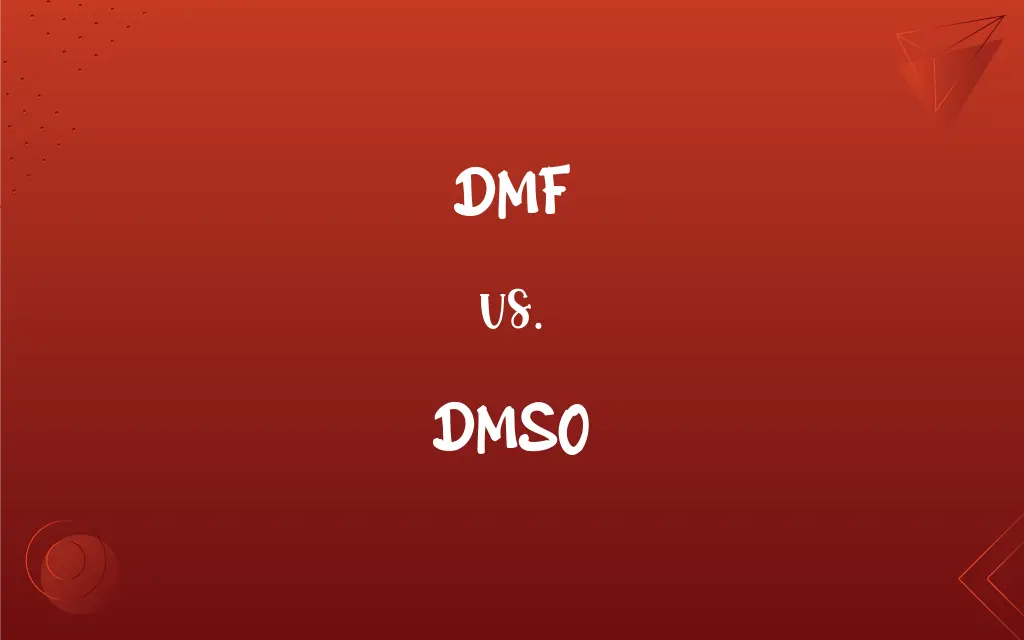DMF vs. DMSO: What's the Difference?
Edited by Aimie Carlson || By Harlon Moss || Published on February 25, 2024
DMF (Dimethylformamide) is a polar organic solvent used in chemical reactions, whereas DMSO (Dimethyl Sulfoxide) is a solvent known for its ability to penetrate biological membranes.

Key Differences
DMF, or Dimethylformamide, is a polar, aprotic solvent widely used in industrial and chemical processes. DMSO, standing for Dimethyl Sulfoxide, is also a polar solvent but is unique for its ability to penetrate skin and other organic membranes.
In chemical synthesis, DMF is often chosen for its high boiling point and ability to dissolve a wide range of substances. DMSO, on the other hand, is frequently used in pharmaceuticals and biotechnology for its transdermal carrier properties.
DMF is known for its effectiveness in facilitating reactions involving polar and nonpolar compounds. DMSO is valued in medicine for its analgesic properties and as a compound that can carry other drugs through the skin.
The safety profile of DMF includes precautions due to its potential toxicity and irritant nature. DMSO is generally considered safer, with its most notable side effect being a garlic-like taste and odor upon consumption.
Both DMF and DMSO are important solvents in their respective fields, they differ significantly in terms of their chemical properties, applications, and safety profiles.
ADVERTISEMENT
Comparison Chart
Chemical Structure
A compound with a formamide group
A compound with a sulfoxide group
Boiling Point
High boiling point
Relatively high boiling point
Main Uses
Industrial and chemical synthesis
Pharmaceutical and biotechnology
Solubility Characteristics
Dissolves both polar and nonpolar compounds
Known for penetrating organic membranes
Safety and Side Effects
Potentially toxic and an irritant
Safer, with garlic-like taste as a side effect
ADVERTISEMENT
DMF and DMSO Definitions
DMF
It is widely used in industrial and chemical synthesis.
DMF is commonly found in pharmaceutical manufacturing processes.
DMSO
DMSO is a solvent known for its ability to penetrate biological membranes.
DMSO was used to deliver the drug through the skin effectively.
DMF
It has a high boiling point, making it suitable for high-temperature reactions.
The reaction was conducted at a high temperature, so DMF was the solvent of choice.
DMSO
It is safer compared to many other solvents, with minimal side effects.
DMSO is preferred due to its safety profile in topical treatments.
DMF
DMF is effective in dissolving a range of substances.
DMF's ability to dissolve various compounds made it ideal for our experiment.
DMSO
It is used in pharmaceuticals for its transdermal carrier properties.
The pain relief cream contains DMSO to enhance absorption.
DMF
DMF is a polar aprotic solvent used in chemical processes.
We used DMF to dissolve the reagents in our synthesis.
DMSO
DMSO has analgesic properties and carries other drugs through the skin.
The DMSO in the ointment helps to alleviate pain upon application.
DMF
DMF can be toxic and requires careful handling.
We ensured proper safety measures when handling DMF due to its toxicity.
DMSO
DMSO can leave a garlic-like taste and odor as a side effect.
Some patients report a garlic taste after using DMSO-based products.
DMSO
A colorless hygroscopic liquid, (CH3)2SO, obtained from lignin, used as an industrial solvent and in medicine as a penetrant to convey medications into the tissues.
FAQs
Can DMSO penetrate skin?
Yes, it's known for its skin penetration ability.
What is DMSO used for?
As a solvent in pharmaceuticals and for transdermal drug delivery.
Are DMF and DMSO interchangeable?
No, they have different properties and applications.
Is DMSO safe to use?
Generally safe, but can cause a garlic-like taste and odor.
Is DMF toxic?
Yes, it can be toxic and is an irritant.
What is the boiling point of DMF?
It has a high boiling point, suitable for high-temperature reactions.
What is DMF used for?
Mainly in chemical synthesis and industrial processes.
Is DMSO used in medicine?
Yes, especially in topical medications and creams.
Can DMSO carry other substances through the skin?
Yes, it's used to enhance transdermal drug delivery.
How is DMF typically handled in the lab?
With precautions due to its potential toxicity.
What makes DMSO unique as a solvent?
Its ability to penetrate biological membranes.
What are the main applications of DMSO in biotech?
As a carrier solvent and in cryopreservation.
Is DMF polar or nonpolar?
It is a polar aprotic solvent.
What is a notable side effect of DMSO?
A garlic-like taste and odor.
Is DMSO a high boiling point solvent?
It has a relatively high boiling point.
Can DMF dissolve nonpolar compounds?
Yes, it can dissolve both polar and nonpolar substances.
Why is DMF important in chemical synthesis?
Due to its ability to dissolve a wide range of chemicals.
How does DMSO help in drug delivery?
By carrying drugs through the skin more effectively.
What safety measures are required for handling DMF?
Use of gloves, goggles, and proper ventilation.
Are there any special storage requirements for DMF?
It should be stored in a cool, dry, and well-ventilated area.
About Author
Written by
Harlon MossHarlon is a seasoned quality moderator and accomplished content writer for Difference Wiki. An alumnus of the prestigious University of California, he earned his degree in Computer Science. Leveraging his academic background, Harlon brings a meticulous and informed perspective to his work, ensuring content accuracy and excellence.
Edited by
Aimie CarlsonAimie Carlson, holding a master's degree in English literature, is a fervent English language enthusiast. She lends her writing talents to Difference Wiki, a prominent website that specializes in comparisons, offering readers insightful analyses that both captivate and inform.































































